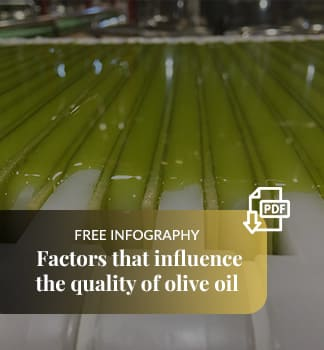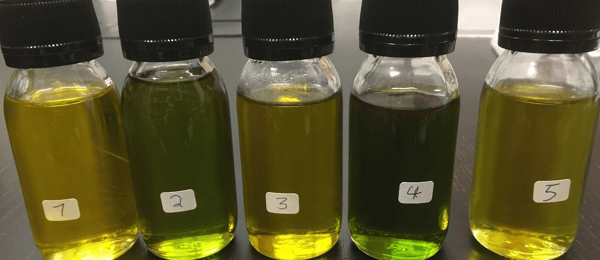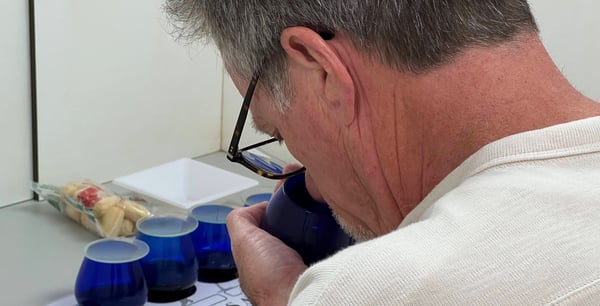Listen to this article
Before starting with the different aspects to take into account in an oil tasting, we will give a brushstroke on the importance of Virgin Olive Oil at the international level.
The Mediterranean diet, increasingly implemented worldwide, has helped in the proven path towards the consumption of healthy products. In turn, there is a growing increase in the consumption of organic products, even in times of crisis, this increase has followed an upward line.
Global awareness of the importance of healthy fats in the diet is becoming a reality. This momentum has been increased thanks to the Mediterranean diet, declared Intangible Heritage of Humanity by UNESCO. The UNESCO Intergovernmental Committee for the Safeguarding of the Intangible Cultural Heritage agreed to inscribe the Mediterranean Diet on the representative list of the cultural heritage of Humanity. Olive Oil is found as a fundamental pillar within this diet.
The Predimed study is another of the studies that bears the banner of the benefits of Virgin Olive Oil for health. Since it was launched in early 2000, it has been shown that the supplement in the Mediterranean Diet with Extra Virgin Olive Oil is capable of reducing the risk of cardiovascular accidents by more than 30%.
In the discovery of the ancient city of Ebla and its archives, in northern Syria, there are documents dated around 2,500 BC that show the importance of olive cultivation. Woody that occupies the third place in cultivation extension. At this time, the price of Olive Oil was five times higher than that of wine and two and a half times more expensive than that of seeds (sesame and flax).
Virgin Olive Oil is undoubtedly a functional food, full of characteristics, aromas, flavors, with an infinite gastronomic potential that, of course, little fat has. However, it is the great unknown for the majority of the population, despite the fact that its use should be a matter of public health.
In our task of spreading the culture of Extra Virgin Olive Oil, we understand that professionals in the olive sector as well as the final consumer must have some basic notions about the tasting of virgin olive oil. Today, sensory analysis is one of the most important tools to know what quality of virgin olive oil we are facing and therefore how much we have to pay for it.
ESAO Oil Tasting. ESAO Image Bank
We are going to see the different aspects to take into account in an oil tasting to, in this way, bring the culture of Extra Virgin Olive Oil tasting to the population.
Classification
First of all, we must know the different categories of olive oils, both those that are virgin and those that are not virgin, that is, those that have gone through a refining process:
NAMES AND DEFINITIONS OF VIRGIN OLIVE OILS.
- Extra Virgin Olive Oil (EVOO)
It is the highest classification and the highest category. Extra Virgin Olive Oil is one that has not undergone any refining process, that is, it is a fruit juice, in this case the olive. They are usually not very ripe olives, in a healthy state and with a good production process. In this quality we look for aromas of nature, grass, green tomato, fresh fruit, etrc but without anomalous aromas.
Olives in a healthy state. ESAO Image Bank
- Virgin Olive Oil (AOV)
It is the second category of Virgin Olive Oil. At a sensory level, it is a Virgin Olive Oil, which has not undergone any refining process, that is, it is an olive juice, but it will have some anomaly or defect. For example, that it is rancid or that the olives with which it has been processed are very ripe.
Olives with defect. ESAO Image Bank
- Lampante Virgin Olive Oil
It is the last category in virgin olive oils. It is a Virgin Olive Oil with a high anomaly, with high scores of defects. These are oils not suitable for human consumption in the form in which they are obtained, they are destined for refining industries or for technical uses.
Very ripe olives with a high defect. ESAO Image Bank
These three categories at the physicochemical level also have their differences, which we will see later.
NOMINATIONS AND DEFINITIONS OF NON-VIRGIN OLIVE OILS.
- Refined olive oil
Lampante oils, as we have said, will be taken to the refinery, and will be refined. However, they will have to be mixed with virgin olive oil to be able to consume them.
- Olive Oil - Contains exclusively refined olive oils and virgin olive oils
Olive oil that, having been obtained from a mixture of refined olive oil and virgin olive oil other than lampante
- Crude olive pomace oil
Oil obtained from olive pomace by means of a treatment with solvents or using physical means, or which corresponds, except for certain characteristics, to lampante olive oil. It cannot be consumed and has to be refined.
- Refined Olive Pomace Oil
Oil obtained from the refining of crude olive-pomace oil.
- Pomace olive oil
Oil that, having been obtained from a mixture of refined olive pomace oil and virgin olive oil other than lampante.
Bottles of refined oil
As a summary, the different types of olive oils that are intended for consumption are:
- Extra Virgin Olive Oil
- Virgin Olive Oil
- Olive Oil - contains exclusively refined olive oils and virgin olive oils
- Olive Pomace Oil.
Negative Atributes or defects
We must have some notions about what are defects or anomalies in virgin olive oils. We understand by default an anomaly or alteration within the evaluation of a Virgin Olive Oil. In most cases they are perceived on the nose, despite the fact that each time we find that it will be the aftertaste who gives us the track.
Currently there are five defects determined by the International Olive Council (IOC), and which are those that through the profile sheet will classify virgin olive oil in one or another category.
It should be noted that the defects are rarely found in their pure state. The defects usually come mixed and you have to be trained to recognize them and especially to detect which is the priority defect found in a certain sample.
The five defects are:- Atrojado / Borras: characteristic aroma of the oil obtained from olives piled up or stored in such conditions that they have undergone an advanced degree of fermentation. This defect occurs when the harvested olives are stored incorrectly and for longer than they should.
- Mold-humidity: aroma reminiscent of humidity or mold.
- Winey / Vinegar-vinegar / acid-sour: aroma reminiscent of wine or vinegar. It is mainly due to a fermentation process of olives or the remains of olive paste that have not been properly cleaned.
- Wet wood: aroma reminiscent of wet wood or wet esparto. It comes from olives that have been frozen on the tree.
- Rancid: Aroma of oils that have undergone an oxidative process. It is one of the simplest defects to perceive, since it is the one to which the human is most accustomed.
Panel Test
You have to know what a test panel is. When a virgin olive oil is classified, we need two analytics. One is the physical chemistry that will give us the results according to the established parameters of acidity, peroxides, k, etc. and another analytical is the sensory or tasting.
This tasting or sensory analysis of the sample will not be carried out by one person alone, but will be carried out by a Tasting Panel. A tasting panel is made up of a group of 8 to 12 people trained and trained, in this case in the sensory characteristics of Virgin Olive Oil. The tasting panels meet once a week.
Oil tasting panel. ESAO Image Bank
Tasting cups
You have to know which are the utensils that we use in the Virgin Olive Oil tasting. We recommend the watch glass. It is a round glass, as a lid for the oil glass, and, in this way, leave the aromas of virgin olive oil condensed inside the glass and be able to take better advantage of them when we uncover it. The amount to pour into the oil cup will be about 15 ml. This is about a finger of Virgin Olive Oil.
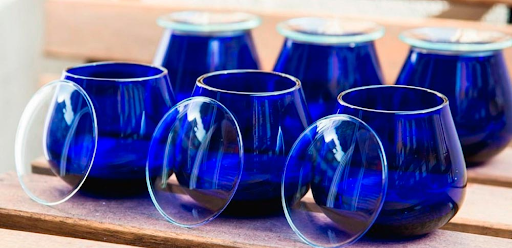 Tasting glasses with watch glass
Tasting glasses with watch glass
Protocol and tasting Technique
Fifth, you have to know the protocol and tasting technique. We have been looking at the different aspects to take into account in an oil tasting, and, in this way, we can proceed to know the protocol and the tasting technique.
Let's take the tasting glass, always covered by the watch glass. We will hold it by the base. Once we have the glass in hand, covered, and seeing that we have the appropriate temperature of + - 28 degrees, we will uncover the glass and do a first and brief olfaction, this producing a sensation.
We will cover the glass and proceed to a second, more continuous olfaction. We will try here to concentrate and name these sensations, which we will call perception. We will discover here the positive or negative notes that appear.
It is common to have expressions such as "it reminds me of something and I don't know what", this should not worry us and little by little if we continue tasting over time, we will see how we will give it a name.
We will write down all the aromas that the sample evokes, whether they are positive or negative sensations, or anomalous (defects). Once we have noted both the positive and negative notes, we will go to the mouth.
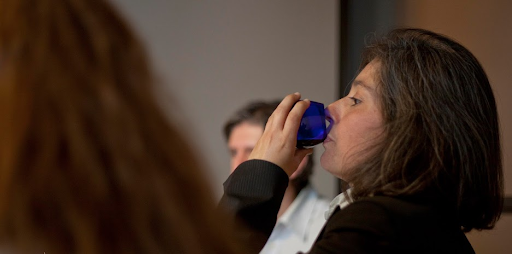
Olive Oil tasting. ESAO Image Bank
We will put a sufficient amount in the mouth of the sample that you have smelled. The amount would be like a tablespoon, about 3 ml approximately. It must be remembered that it must pass over the entire oral surface.
The job in the mouth when tasting Virgin Olive Oil is to detect the intensity of bitter and spicy, as well as to detect the presence or absence of defects through the aftertaste.
Both bitter and spicy are positive attributes in Virgin Olive Oil, since they are related to phenols, vitamins and antioxidants in virgin olive oil. We will not swallow the Virgin Olive Oil without first having it in our mouth for a few seconds to detect its bitterness before proceeding to evaluate the spiciness.
It should not be forgotten that the majority of consumers of Virgin Olive Oil are not experts, just as there are markets that do not have a culture of Virgin Olive Oil and that we must try to soften the bitter and aggressive spiciness. However, we have several studies regarding the phenolic properties or components such as oleocanthal that help us defend these spicy and bitter sometimes so powerful.
Once the work has been carried out and noted both in the nose and in the mouth, we will analyze the results, and in case of not having a defect, we will be faced with an extra Virgin Olive Oil (provided that the physicochemical analysis also classifies it as such). In case of having a not very high defect noted (up to 3.5 on a scale of 1 to 10) we will be dealing with a Virgin Olive Oil and if we see that the anomaly or defect is very high (higher than 3.5 in a scale from 1 to 10) will be a lampante oil.
When it comes to an official virgin olive oil tasting, we use some cards, called profile sheets. In these files, we have scales from 0 to 10 and where the intensity is noted, both of the attributes in the nose and in the mouth, but this is already a more advanced and specific topic that you can develop on campus. This same scale is used to list the defects and thus proceed to classify a Virgin Olive Oil.
All those interested in this information, in the tasting training, will work and see, all the details related to the tasting of Virgin Olive Oil in a developed way, including the physicochemical parameters.
Finally, comment that these would be part of the most important aspects to take into account in an oil tasting, but there are more that we would like to leave named as they are:
- Characteristics of a tasting room
- The best time for Tasting
- Sample difficulties
- Difficulties of a taster
- General vocabulary for the flavor of olive oil
- Tasting regulations
- Sensory analysis
- Main descriptors of olive oil
.png)

